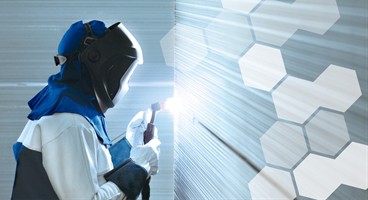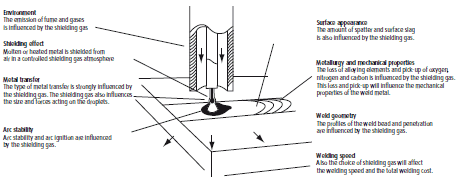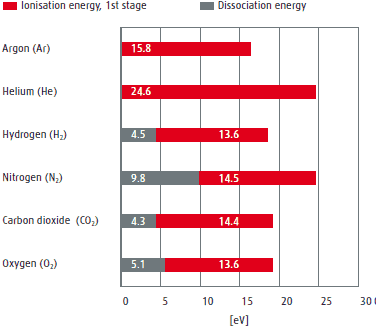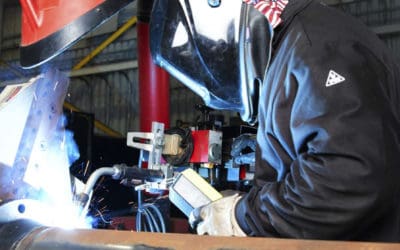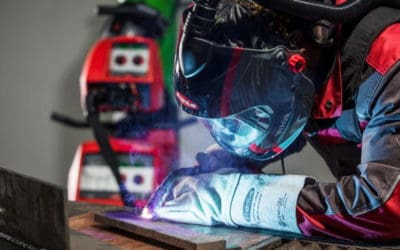Abstract
In fabrication or construction, the goal is higher product quality with improved performance. This is especially important with relation to the GMA and TIG welding processes. I have heard many people comment to me that shielding gases only protect the welding arc from atmospheric attack whilst this is partly true, shielding gases do much more than that. This paper will explore and explain the properties of various shielding gases and clearly show the benefits of selecting the correct shielding gas for the right application. I have broken this down into material types and also processes using various shielding gases. The under utilisation in the South Pacific of shielding gases containing additions of hydrogen, helium and nitrogen are compared with traditional mixtures such as argon and the benefits are staggering. The quality and economics are quantified and it is clear that using the correct shielding gas shows dramatic benefits. The economics have been qualified by completing a weld-cost calculation. This was achieved using a Linde DMG5 data logger. I believe we should no longer call these products shielding gases moving forward but welding gases as they do much more than shield the molten metal or arcs from atmospheric attack. Shielding gases are an optimisation tool and not a commodity.
Introduction
Shielding/Welding Gases with a balance gas of Argon and additions of Carbon Dioxide and Oxygen or mixtures thereof have been utilised since the early 1970’s commercially. My late friend, mentor and colleague Mr Hans Pomaska was very active in the development of these types of mixtures. Continuing on from his work we now use additions of hydrogen, helium and Nitrogen or mixtures thereof. The benefits and percentage of mixtures are explored and explained in many laboratory trials ,papers and field work with a clear focus on the selection of the correct Argoshield® Stainshield® or Alushield®. With Linde and BOC coming together the depth of knowledge and understanding in this field is second to none.
The role of shielding gas – What shielding gas can do
The primary function of the shielding gas in gas-shielding arc welding has been to protect molten and heated metal from the damaging effects of the surrounding air and to provide suitable conditions for the arc. If air comes in contact with the molten or heated metal, the oxygen in the air will oxidise the metal, the nitrogen might cause porosity or brittleness in the weld metal, and moisture from the air may also cause porosity.
The shielding gas composition affects the material transfer from the molten electrode to the weld pool, which in turn influences the amount and size of the spatter created. It also affects the appearance of the weld bead, the weld geometry, the welding speed and plays a key role in the burn-off of alloying elements (which affects material strength) or oxide formation on the bead surface. These effects can be clearly demonstrated in real time using BOC’s new GMA and TIG arc projectors.
The influence of shielding gas upon GMA welding
Environment
- The emission of fumes and gases is influenced by the shielding gas.
Shielding effect
- Molten metal or tungsten electrode is shielded from the air in a controlled shielding gas atmosphere.
Metal transfer
- The type of metal transfer is strongly influenced by the shielding gas. The shielding gas also influences the size and forces acting on the droplets.
Arc stability
- Arc stability and arc ignition are influenced by the shielding gas.
Surface appearance
- The amount of spatter and surface slag is also influenced by the shielding gas.
Metallurgy and mechanical properties
- The loss of alloying elements and pick-up of oxygen, nitrogen, and carbon is influenced by the shielding gas. This loss and pickup will influence the mechanical properties of the weld metal.
Weld geometry
- The profiles of the weld bead and penetration are influenced by the shielding gas.
Welding speed
- The choice of shielding gas will affect the welding speed and the total welding cost.
Effects of the different shielding gas components
Argon
Argon (Ar) is an inert gas. This means it does not oxidise and that it has no effect on the chemical composition of the weld metal. Argon is the main component in most shielding gases for GMA and GTA welding.
Carbon dioxide and oxygen
Pure argon cannot be used for GMA welding of steels since the arc becomes too unstable. An oxidising gas component is therefore used to stabilise the arc and to ensure a smooth metal transfer during welding. This oxidising component may be Carbon Dioxide (C02), Oxygen (02) or a combination of these gases. The amount of the oxidising component added will depend on the material type and application.
The electrical arc in gas metal arc welding can be divided into three parts: the arc plasma, the cathode area and the anode area. In GMA welding, where the filler metal constitutes the positive electrode (the anode), the cathode area is on the workpiece in the form of one or more cathode spots. The oxidising additive is necessary to stabilise these cathode spots, otherwise the arc tends to flicker around on the surface of the workpiece, forming spatter, irregular weld beads and minimal penetration.
The metal transfer and penetration profile can be changed by selecting different argon-carbon dioxide mixtures. The figure above shows the type of metal transfer in spray arc and typical penetration profile for mixtures with 2% C02 up to pure C02. Higher C02 content gives better side wall penetration but more spatter and fume. For most applications, the penetration given by a few percent of C02 is acceptable. A spray arc cannot be achieved when using 100% C02.
Carbon dioxide or oxygen?
There are often advantages in using C02 in argon. One is the slight improvement in weld geometry and appearance over oxygen-argon mixtures. This occurs because of the differences in weld pool fluidity, surface tension and oxides in the molten metal. With C02 instead of 02, there is also less oxidation and slag formation which can have an effect on the appearance of the weld as well as the need for cleaning the weld.
Another advantage is improved penetration, especially side wall penetration. This is mainly a factor of the higher arc voltage and the energy employed when welding with C02 in the mixture.
Helium
Helium (He) is like argon – an inert gas. Helium is used together with argon and a small percent of C02 or 02 for GMA welding of stainless steel. In its pure state, or mixed with argon, it is used as a shielding gas for GTA and MIG welding. Compared with argon, helium provides better side wall penetration and higher welding speeds, by generating a more energy-rich arc. The process is more sensitive to arc length variations with helium as a shielding gas, however, the arc is more difficult to strike when TIG welding.
Hydrogen
Hydrogen (H2) can be added to shielding gases for GTA welding of austenitic stainless steels in order to reduce oxide formation. The addition also means more heat in the arc and a more constricted arc, which improves penetration. It also gives a smoother transition between the weld bead and base metal.
For root protection purposes, hydrogen addition is commonly used. It is not recommended for root purging of ferritic,martensetic,aluminium,titanium,,Duplex steels. For this application, argon or high purity nitrogen should be used.
Nitrogen
Nitrogen (N2) is used as an additive in shielding gases for GTA welding of austenitic, duplex and superduplex stainless steels. These steels are alloyed with up to 0.5% nitrogen in order to increase the mechanical properties and resistance against pitting. If the shielding gas contains a few percent of nitrogen, nitrogen losses in the weld metal can be reduced. Nitrogen with 5% hydrogen is a common purging gas that delivers a good reducing effect. Pure nitrogen will further increase pitting resistance at the root when welding austenitic duplex and superduplex stainless steels.
Properties for specific uses
An in-depth understanding of the ‘internal properties’ of gas components and their interaction in specialised mixtures is essential for successful use of process gases in specific welding applications. The welding arc itself, a highly efficient but complex tool, consists largely of different amounts of ionised gas and metal vapour. This means the physical properties of the gas have a direct and immediate impact on the arc. In addition, the process gases also contact the hot metal, a highly reactive area, in which the chemical and metallurgical effects of the gases also play an important role. The following criteria serve as examples only and do not claim to be complete.
Dissociation and ionisation energy
Ionisation occurs directly in the case of the monatomic inert gases, Ar and He. Diatomic or polyatomic gases, such as H2 or CO2, have to be initially dissociated in the arc, a process which requires additional energy. The less energy required for these processes, the easier it is to ignite the arc. If components that are comparatively difficult to ionise, such as He or CO2 are present, the welding voltage has to be increased accordingly. However, this additional electrical energy is released again in the form of recombination energy, which can both improve heat input and increase welding speed.
Thermal conductivity
Some of the arc’s heat is transferred to the workpiece via the plasma or gas flow. Especially at high temperatures, the two components He and H2 can significantly improve process efficiency. Good thermal conductivity has a positive effect on seam beadshape, wetting action, degassing of the molten pool – and on welding speed.
Chemical reactivity and metallurgical impact
CO2 and O2 are both active, oxidising gases. Especially at high temperatures, they react quickly with the materials present to form oxides. In appropriate quantities, metal oxides can improve edge wetting, arc stability. If larger percentages of active gases are present, for example, when GMA welding structural steel, the resulting increase in oxidation generates additional heat. The product of oxidation, otherwise known as ‘slag’ or ‘silicate’, is often found on the surface of the bead. O2 as a shielding gas component has a greater oxidising effect than the same quantity of CO2. If quality demands require lower levels of these deposits, the active gas component in the Argoshield®/Stainshield® series can be reduced. However, this should only be done if requirements regarding fusion, penetration and the number of pores are taken into consideration. In the case of a higher CO2 content, carbon pickup may occur, depending on the material being welded.
Thermal conductivity of the gases
Heat transfer from the arc to the base metal depends on the thermal conductivity of the different gases. Helium and hydrogen offer particularly high thermal conductivity values.
N2 is considered a low-activity gas, i.e. whether or not reactions take place depends on the metal and the process conditions. An example of positive reactivity is the austenitising effect of Stainshield® Duplex gases when TIG welding fully austenitic materials or duplex steels. In contrast, the pore-forming or embrittling effect of N2 with GMA welding steel is detrimental.
H2 is unique as a particularly effective reducing component for arc welding. It can be used, for example, in TIG/PAW welding and purging of austenitic stainless steels with Argoplas®5 gas, in other words, in cases in which it is important to prevent oxidation of very expensive and sensitive metals. Owing to their superior thermal conductivity and additional recombination energy, Argoplas®5 gas permits much higher TIG/PAW welding speeds than argon. Unfortunately, these extremely beneficial properties cannot be used for welding all metals. For example, H2 leads to pore formation in aluminium and to cracks in ferritic steels. Thus, H2’s compatibility with a given material always has to be tested.
Ar and He are the inert gases used in welding. Since they do not react with any metal, they can be used with all metals that can be fusion welded.
Other relevant properties:
- Relative density: influences the position-dependent effectiveness of the shielding gas
- Heat transfer coefficient: He can transfer heat to a metal surface much more effectively than Ar
Dissociation and ionisation energy of the gas components
Parameters for ignition properties, welding voltage and arc energy.
Purity levels and mixing accuracies
Shielding gases are standardised in AS 4882 and ISO 14175. These standards specify, amongst other things, the minimum quality requirements of the components and mixtures. However, depending on the material, process, method and quality requirements, higher qualities may be necessary depending on the application. An example is Argon 5.0 (99.999%) is required when welding titanium components.
Conclusion
When selecting a shielding gas for your application, you should consider more than just the cost of the gas. This is quantified in the two weldcost calculations comparing Argon vs Argoplas 5 in the TIG process welding stainless steel and Stainshield Light vs Stainshield Heavy with the GMA process on stainless steel. The shielding gas can be more than twice as expensive and still the overall welding costs can be reduced considerably. Other comparisons or trials that have been conducted are Argon vs Alushield Heavy with GMA Welding and Argon vs Alushield Universal with the TIG Welding process on Aluminium. These cost evaluations have shown similar benefits. It is clear that the quality and economics of welded structures can be greatly improved with the correct selection of a shielding/welding gas. This is very much dependant on the process, material type, wire diameter, power source etc. Some common applications have been explored with favourable results in regards to the additions of helium and hydrogen. Thanks to our considerable field experience, it is possible to increase productivity with a decrease in overall costs due to the correct selection of Argoshield®, Stainshield® or Alushield® (as will be reviewed in further detail in upcoming articles). Process efficiency can be considerably increased by the combination of know-how of gases and their interaction with the processes. If the welding process is the bottle neck in your production, then a through investigation into your welding process should be undertaken. The investigation may well show that the introduction of the optimum shielding gas or gases may be your answer. In conclusion shielding gases are in fact an optimisation tool and not a welding commodity.
BOC – A Member of the Linde Group, Mr Kyle Scott Market Manager – Welding and Industrial Gases, South Pacific
E-mail kyle.scott@boc.com
References
- Linde AG Industrial Gases division -The Linde working Group , Peak performance through innovation and expertise.
- Linde AG Ammann T,Unterschleissheim Gas shielded Arc Welding of Duplex Steels
- Linde AG Kersche A, Trube S, Hoellriegelskreuth, Shielding Gases for Gas –shielded Metal Arc Brazing
- AGA, Industrial Gases division, The AGA working Group, The Shielding Gases Handbook
Acknowledgements
- Mr Peter Kuebler from Linde/BOC for his support in editing this paper.
- Mr Ernst Miklos and the Linde Applications department in Lohof Germany with whom I have worked closely with over the last 22 years on the development of welding gases.
- Mr Bob Eden from Linde/BOC UK with whom I have exchanged practical experiences with over many years.
- The Applications Engineers and Welding specialist from Linde/BOC South Pacific who have conducted many practical trials on Welding Gases in the market.
